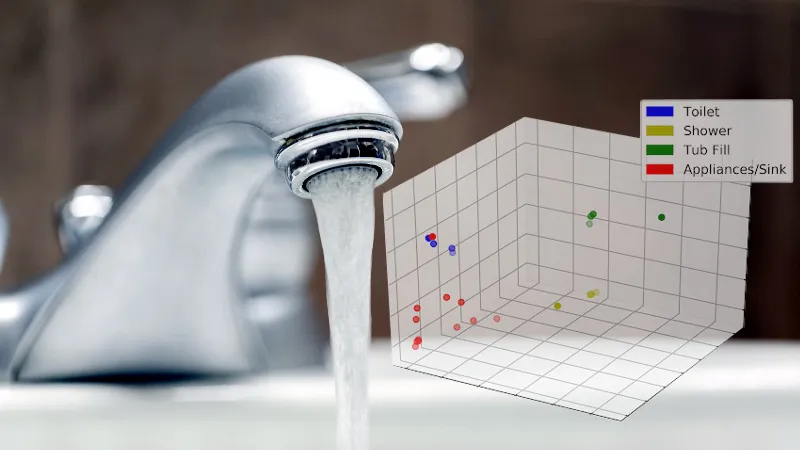
Principle And Working Mechanism Of Acoustic Tomography In Water Data Metering
Acoustic Tomography Is A Powerful Technology Used For Water Data Metering And Monitoring. It Utilizes Sound Waves To Gather Information About Water Properties, Such As Temperature, Flow Velocity, And Turbidity. This Blog Will Discuss The Principle And Working Mechanism Of Acoustic Tomography In Water Data Metering, As Well As Its Applications In Water Resource Management.
Principle Of Acoustic Tomography
Acoustic Tomography Relies On The Transmission And Reception Of Sound Waves Through Water. The Device Consists Of Multiple Transducers Strategically Placed Around A Water Body. These Transducers Emit Short Pulses Of Sound Waves, Which Propagate Through The Water And Are Received By Other Transducers. The Time Taken For The Sound Waves To Travel Between Transducers Is Measured, And This Data Is Used To Calculate Various Water Parameters.
Working Mechanism Of Acoustic Tomography
The Working Mechanism Of Acoustic Tomography Involves The Transmission And Reception Of Sound Waves Through Water To Gather Information About Various Water Properties. The Acoustic Tomography Device Consists Of Transducers Strategically Placed Around A Water Body. These Transducers Emit Short Pulses Of Sound Waves At A Specific Frequency, Which Travel Through The Water And Interact With Different Water Properties Such As Temperature, Flow Velocity, And Turbidity. The Scattered Sound Waves Are Then Received By The Transducers, Which Convert Them Into Electrical Signals. The Time Taken For The Sound Waves To Travel Between Transducers Is Measured And Used To Calculate Water Parameters. By Analyzing The Collected Data And Employing Sophisticated Algorithms, Accurate Measurements Of Flow Velocity, Temperature Profiles, Turbidity Distribution, And Other Water Properties Can Be Obtained. The Working Mechanism Of Acoustic Tomography Enables Its Applications In Various Areas Of Water Resource Management, Including Flow Monitoring, Water Quality Analysis, Sediment Transport Assessment, And Aquatic Ecosystem Monitoring.
Transducer Emission
The Acoustic Tomography Device Emits Short Pulses Of Sound Waves At A Specific Frequency. These Waves Are Generated By The Transducers, Which Are Strategically Placed Around The Water Body. The Emitted Sound Waves Serve As The Probing Signal That Will Travel Through The Water And Interact With Different Water Properties.
Propagation And Scattering
As The Sound Waves Propagate Through The Water, They Encounter Variations In Water Temperature, Flow Velocity, And Turbidity. These Variations Cause The Sound Waves To Scatter Or Refract, Altering Their Travel Paths. The Scattering And Refraction Phenomena Are Influenced By The Density And Speed Of Sound In The Water, As Well As The Gradients Of The Water Properties. The Scattered Waves Carry Information About The Properties They Encountered During Their Journey.
Reception And Data Collection
The Scattered Sound Waves Are Received By The Transducers Located At Different Positions Around The Water Body. The Transducers Act As Receivers And Convert The Received Acoustic Signals Into Electrical Signals. These Electrical Signals Are Then Processed And Stored For Further Analysis. The Transducers Are Designed To Be Sensitive To A Wide Range Of Frequencies To Capture The Scattered Waves Effectively.
Data Analysis
The Time Taken For The Sound Waves To Travel Between Transducers Is Measured Accurately. This Time-Of-Flight Data Provides Valuable Information About The Distance Traveled By The Waves And The Properties They Encountered Along Their Path. By Using Sophisticated Algorithms And Mathematical Models, The Collected Data Is Analyzed To Calculate Water Parameters Such As Flow Velocity Profiles, Temperature Distributions, And Turbidity Levels. The Analysis Involves Comparing The Measured Time Differences With The Known Positions Of The Transducers To Triangulate The Location Of The Sound Source Or The Point Of Interest In The Water Body. This Allows For The Extraction Of Precise And Detailed Information About The Water Properties.
Overall, The Working Mechanism Of Acoustic Tomography Involves Emitting Sound Waves, Observing Their Propagation And Scattering In The Water, Receiving The Scattered Waves, And Analyzing The Collected Data To Determine Various Water Parameters. This Process Enables Accurate And Comprehensive Characterization Of The Water Body And Aids In Various Applications, From Understanding Fluid Dynamics To Monitoring Environmental Changes.
Applications Of Acoustic Tomography In Water Resource Management
- Flow Monitoring: Acoustic Tomography Can Measure Flow Velocity And Direction In Rivers, Canals, And Pipelines. This Information Is Crucial For Water Resource Management, Flood Forecasting, And Optimizing Water Distribution Systems.
- Water Quality Monitoring: By Analyzing The Scattering Patterns Of Sound Waves, Acoustic Tomography Can Provide Insights Into Water Quality Parameters Such As Turbidity, Suspended Solids, And Dissolved Oxygen Levels. This Helps In Identifying Pollution Sources And Assessing The Overall Health Of Water Bodies.
- Sediment Transport Analysis: Acoustic Tomography Is Useful In Studying Sediment Transport And Erosion Patterns In Rivers And Reservoirs. It Helps In Understanding Sediment Dynamics, Estimating Sediment Volumes, And Planning Effective Sediment Management Strategies.
- Aquatic Ecosystem Monitoring: Acoustic Tomography Enables The Monitoring Of Aquatic Ecosystems By Assessing Factors Like Temperature Profiles, Stratification, And Mixing Patterns. This Information Aids In Studying The Impact Of Environmental Changes On Aquatic Life And Ecosystem Health.
Types Of Acoustic Tomography Devices
There Are Different Types Of Acoustic Tomography Devices Used For Water Data Metering, Including:
- Single-Point Acoustic Tomography: Utilizes One Transducer As Both The Transmitter And Receiver, Allowing For Localized Measurements Of Water Properties At Specific Points. This Method Provides Focused And Precise Data On Specific Areas Of Interest.
- Array-Based Acoustic Tomography: Consists Of A Larger Number Of Transducers Forming An Array, Expanding The Coverage Area For Data Collection. By Utilizing Multiple Transducers, This Configuration Enables The Simultaneous Collection Of Data From Various Points, Providing A More Comprehensive Understanding Of Water Properties Across A Wider Area.
- Continuous Wave Acoustic Tomography: This Type Of Acoustic Tomography Device Emits A Continuous Wave Instead Of Short Pulses. By Measuring The Phase Shift And Attenuation Of The Continuous Wave As It Propagates Through The Water, This Method Allows For Accurate Measurement Of Flow Velocity And Turbulence In The Water Body. This Continuous Wave Approach Is Particularly Useful For Studying Dynamic Processes And Fluid Behavior In Real-Time.
- 3D Acoustic Tomography: This Advanced Type Of Acoustic Tomography Utilizes An Array Of Transducers Arranged In Three Dimensions. It Allows For The Collection Of Data Not Only Along The Horizontal Plane But Also Vertically, Providing A Three-Dimensional View Of Water Properties. This Enables A More Detailed Analysis Of Water Flow Patterns, Temperature Distributions, And Other Parameters.
- Acouinfo: Measuring Rivers’ Velocity And Flow Rate Is One Of The Most Critical Issues In Water Resources Management. For The Past Two Decades, Scientists Have Been Using Sound Waves To Estimate Current Speed. Advanced Devices Such As ADCP, AVMs, And H-ADCPs Continuously Measure River Flow. The Most Significant Disadvantage Of Using These Devices Is That They Measure The Velocity Of A Limited Number Of Points Of A River Cross-Section, And These Points Are Insufficient To Accurately Estimate The Average Speed Of The Entire Cross-Section.
Data Measurement By Acoustic Thermography: Method Of River Model
To Accurately Measure The Key Parameters Of The Aquatic Environment Such As Flow Rate, Speed, Temperature, And Salinity Of Water, A Device Is Needed That Can Record And Measure All These Parameters With Confidence and high Accuracy, Simultaneously, Quickly, And Easily. Using This System, It Is Possible To Provide Information On The Desired Aquatic Environment At Any Time, Even Remotely To Experts In Various Fields Such As Water Management, Agriculture, Meteorology, Floods, Fisheries, Biology, And .. To Be Used.
AcouInfo Has Advantages Over Other Types
AcouInfo Has Two Transmitters And Receivers That Are Used On Both Sides Of The River By Emitting Sound Waves Throughout The River And Recording Information from the Processor Of The Device, These Parameters Are Measured By Acoustic Tomography Methods Of Water.
Measurement Of Water Parameters In The Whole Section Of The River
No Need For Equipment Such As Boats, Cable Cars, And Special Infrastructure
Suitable For All Types Of Shallow And Deep Rivers
Suitable For Monitoring Very Severe Flood Currents
No Need For Specialized Manpower To Take Data And Set Up The Device
No Human Intervention During Data Collection And Maintaining User Safety
Fixed Location Of Device Equipment During Data Collection Convenient And Fast Setup In Portable Mode
Innovative Point Of Our Product:
Ability To Display Instant Results
Lightweight And High Operating Speed
Data Storage For A Long Time
Transfer Recorded Data To Computer Via Bluetooth And Wi-Fi
Ability To Receive And View Information Online Via The Internet
Can Be Used In Any Weather Conditions
Can Be Used In Shallow Rivers With A Minimum Depth Of 25 Cm
Calculate Water Flow Velocity In The Range Of M 20 M / S With An Accuracy Of 0.1 Cm / S
Calculate The Instantaneous Water Temperature With An Accuracy Of 0.03 ° C
Each Type Of Acoustic Tomography Device Has Its Advantages And Applications. The Choice Of Device Depends On The Specific Requirements Of The Water Monitoring Task, Such As The Desired Spatial Resolution, The Depth Of The Water Body, And The Parameters Of Interest. By Utilizing These Different Types Of Devices, Acoustic Tomography Can Provide Valuable Insights Into Water Properties And Contribute To Effective Water Resource Management And Environmental Monitoring
In Conclusion, Acoustic Tomography Is A Valuable Technology For Water Data Metering And Monitoring.
By Understanding Its Principle And Working Mechanism, We Can Appreciate Its Applications In Water Resource Management, Including Flow Monitoring, Water Quality Analysis, Sediment Transport Assessment, And Aquatic Ecosystem Monitoring. With Advancements In Technology, Acoustic Tomography Continues To Play A Significant Role In Understanding And Managing Our Precious Water Resources.
